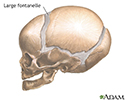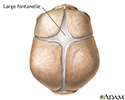Fontanelles - enlarged
Soft spot - large; Newborn care - enlarged fontanelle; Neonatal care - enlarged fontanelleEnlarged fontanelles are larger than expected soft spots for the age of a baby.
The skull of an infant or young child is made up of bony plates that allow for growth of the skull. The borders at which these plates intersect are called sutures or suture lines. The spaces where these connect, but are not completely joined, are called soft spots or fontanelles (fontanel or fonticulus).
-
Considerations
Fontanelles allow for growth of the skull during an infant's first year. Slow or incomplete closure of the skull bones is most often the cause of a wide fontanelle.
##RemoveMe##
-
Causes
Larger than normal fontanelles are most commonly caused by:
- Down syndrome
- Hydrocephalus
- Intrauterine growth retardation (IUGR)
- Premature birth
Rarer causes:
- Achondroplasia
- Apert syndrome
- Cleidocranial dysostosis
- Congenital rubella
- Neonatal hypothyroidism
- Osteogenesis imperfecta
- Rickets
##RemoveMe##
-
When to Contact a Medical Professional
If you think that the fontanelles on your baby's head are larger than they should be, talk to your health care provider. Most of the time, this sign will have been seen during the baby's first medical exam.
##RemoveMe##
-
What to Expect at Your Office Visit
An enlarged large fontanelle is almost always found by the provider during a physical exam.
- The provider will examine the child and measure the child's head around the largest area.
- The doctor may also turn off the lights and shine a bright light over the child's head.
- Your baby's soft spot will be regularly checked at each well-child visit.
Blood tests and imaging tests of the head may be done.
##RemoveMe##
References
Haddad J, Keesecker S. Congenital malformations. In: Kliegman RM, Stanton BF, St. Geme JW, Schor NF, eds. Nelson Textbook of Pediatrics. 20th ed. Philadelphia, PA: Elsevier; 2016:chap 638.
Robinson S, Cohen AR. Disorders in head shape and size. In: Martin RJ, Fanaroff AA, Walsh MC, eds. Fanaroff and Martin's Neonatal-Perinatal Medicine: Diseases of the Fetus and Infant. 10th ed. Philadelphia, PA: Elsevier Saunders; 2015:chap 64.







